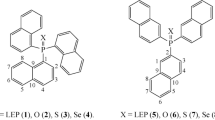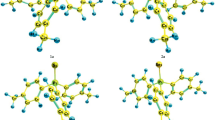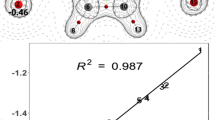Abstract
The semiempirical CNDO/2 method has been used in a quantum-chemical study of the electronic and spatial structures of a series of phosphaalkenes as influenced by the nature of the substituents on the two-coordinated phosphorus atom and the carbon atom forming the P=C bond, as well as simple models for these. The data are compared with results from nonempirical calculations found in the literature for the latter. The authors discuss the effects of the substituents on the π-electron structures of the phosphaalkenes and the character of the outer orbitals. It is found that the d AO of phosphorus plays only a slight part in forming the bonds in these compounds. The electron-density distributions are close to those found for ethylene derivatives. The conclusions agree with spectral and structural studies on the phosphaalkenes.
Similar content being viewed by others
Literature cited
E. Fluck, “Compounds of phosphorus with coordination number 2,” Topics Phosphor. Chem., 10, 193–284 (1980).
R. Appel, F. Knoll, and I. Ruppert, “Phospha-alkene und Phospha-alkine. Genese und Charakteristika ihrer (p-p)π-Mehrfachbindung,” Angew. Chem., 93, No. 9, 771–784 (1981).
T. A. van der Knaap, T. C. Klebach, F. Visser, et al., “Synthesis and structure of aryl-substituted phosphaalkenes”, Tetrahedron, 40, No. 4, 765–776 (1984).
M. J. Hopkinson, H. W. Kroto, J. F. Nixon, and N. P. C. Simmons, “The detection of unstable molecules by microwave spectroscopy: phosphaalkenes CF2=PH, CH2=PC1 and CH2=PH,” J. Chem. Soc. Chem. Communs., No. 13, 513–515 (1976).
R. Appel, F. Knoch, B. Laubach, and R. Sievers, “Niederkoordinierte P-Verbindungen 18,” Chem. Ber., 116. No. 5, 1873–1879 (1983).
A. N. Chernega, X-Ray Data on the Structures of Derivatives of Phosphorus with Coordination No. 2 and Reaction Products: PhD Thesis [in Russian], Moscow (1965).
M. Yu. Antipin, Yu. T. Struchkov, et al., “The molecular structure of a new derivative of two-coordinated phosphorus: P-trimethyl-C-dimethylamino-C-diethylaminomethylene-phosphine,” Dokl. AN SSSR, 278, No. 5, 1146–1149 (1984).
Yu. T. Struchkov, A. N. Chernega, and M. Yu. Antipin, “Steric structures of two-coordinated phosphorus compounds,” Abstracts for the Eighth All-Union Conference on the Chemistry of Organophosphorus Compounds Dedicated to the Eightieth Anniversary of the Arbuzov Reaction, Kazan1, 13–16 May 1985 [in Russian], part 1, Kazan', p. 14.
C. Thomson, “Electronic structure of phosphaalkenes,” J. Chem. Soc. Chem. Communs., No, 9, 522–523 (1977).
W. W. Schoeller and E. Niecke, “Frontier orbital crossing and ambident reactivity in P(III) systems with (p-p)π-bonds,” ibid., No. 11, 569–570 (1982).
D. Gonbeau, G. Pfister-Guillonzo, and J. Barrans, “Coordinence 2 du phosphore: etude quantochimique des systemes P=N et P=C,” Can. J. Chem., 61, No. 7, 1371–1378 (1983).
J. A. Pople and M. S. Gordon, “Molecular orbital theory of the electronic structure of organic compounds. 1. Substituent effects and dipole moments,” J. Am. Chem. Soc., 89, No. 17, 4253–4261 (1967).
A. S. Tarasevich, V. V. Pen'kovskii, and Yu. P. Egorov, “A CNDO/2 study of electronic structures in phosphazo compounds,” Teor. Eksp. Khim., 13, No. 5, 589–598 (1977).
V. G. Maslov, “A CNDO program for calculating molecular systems including up to 232 orbitals,” Zh. Strukt. Khim., 18, No. 2, 414–415 (1977).
M. W. Schmidt and M. S. Gordon, “Electronic structure of the phosphoryl and thiophosphoryl bonds,” J. Am. Chem. Soc., 107. No. 7, 1922–1930 (1985).
R. Appel, J. Peters, and A. Westerhaus, “Phosphaalkene durch termische, Basen- oder Metall-induzierte Eliminierung,” Tetrahedron Lett., 22, No. 49, 4957–4960 (1981).
V. D. Romanenko, T. V. Sarina, N. V. Kolotilo, and L. N. Markovskii, “C,C-bis(dialkyl-amino) methylenephosphones,” Zh. Obshch. Khim., 55, No. 5, 1188–1190 (1985).
Author information
Authors and Affiliations
Additional information
Translated from Teoreticheskaya i Éksperimental'naya Khimiya, Vol. 22, No. 5, pp. 545–553, September–October 1986.
Rights and permissions
About this article
Cite this article
Pen'kovskii, V.V., Boldeskul, I.E. Quantum-chemical study of intramolecular electronic effects in phosphaalkenes. Theor Exp Chem 22, 520–526 (1987). https://doi.org/10.1007/BF00522536
Received:
Issue Date:
DOI: https://doi.org/10.1007/BF00522536




